EU workers in Scotland's social care workforce: contribution assessment
Provides estimated numbers and specific roles of EU staff in Scotland's social care workforce.
4. Perspectives on recruitment and retention
This chapter builds on the findings presented above by exploring survey respondents’ views on recruitment and retention in the social care sector, including the extent to which they had found it easier or more difficult over the last year to recruit and retain non- UK EU workers.
Recruitment
Ease of recruiting staff in general
The perceived ease of recruiting staff over the last 12 months varied notably depending on the types of post being recruited for. As Table 4.1 shows, over half (51.7%) of those who had tried to recruit NMC registered nurses and over two in five (44.2%) of those who had tried to recruit care staff or practitioners said the process had become more difficult in the last year; this compared with the 21.1% who said the same about recruiting auxiliary staff and the 19.4% who did so about recruiting managers.
Table 4.1: Ease of recruiting in the last 12 months by post type
| Auxiliary staff |
NMC Registered nurses |
Care staff/ practitioners |
Managers |
Other |
|
|---|---|---|---|---|---|
| % | % | % | % | % | |
| A lot easier | 3.2 | 3.1 | 3.1 | 1.7 | 2.3 |
| A little easier | 4.4 | 4.2 | 5.9 | 3.6 | 3.6 |
| No change | 69.1 | 34.7 | 45.1 | 70.7 | 65.5 |
| A little more difficult | 9.5 | 9.6 | 17.7 | 6.0 | 10.2 |
| A lot more difficult | 11.6 | 42.1 | 26.5 | 13.4 | 13.4 |
| Don’t know | 2.2 | 6.3 | 1.7 | 4.5 | 4.9 |
| Easier | 7.6 | 7.3 | 9.0 | 5.3 | 5.9 |
| More difficult | 21.1 | 51.7 | 44.2 | 19.4 | 23.6 |
| Base | 698 | 174 | 1,097 | 625 | 268 |
The results for auxiliary posts showed some variation by sub-sector: respondents working in care homes for adults and housing support/care at home services were over two times more likely than those working in nurse agencies to report increased difficulties recruiting for such posts (22.6% and 22.4% versus 8.8% respectively).
Figure 4.1: Ease of recruiting auxiliary staff in the last 12 months by sub-sector
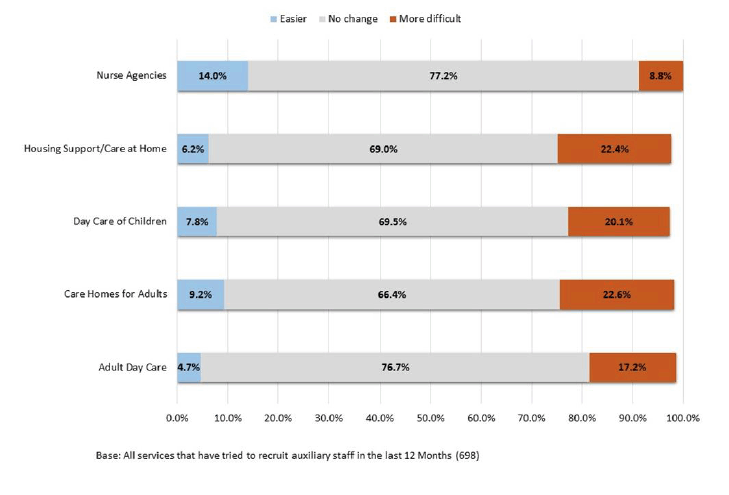
Similar sub-sectoral variation was evident in respect of care staff or practitioner posts. Respondents working in day care of children and housing support/care at home services more likely than those working in adult day care services and nurse agencies to report increasing difficulties recruiting for these posts (48.0% and 47.2% versus 30.5% and 24.1% respectively) ( Figure 4.2). The figure among respondents working in care homes for adults stood at 37.9%, below the average of 44.2%.
Figure 4.2: Ease of recruiting care staff in the last 12 months by sub-sector
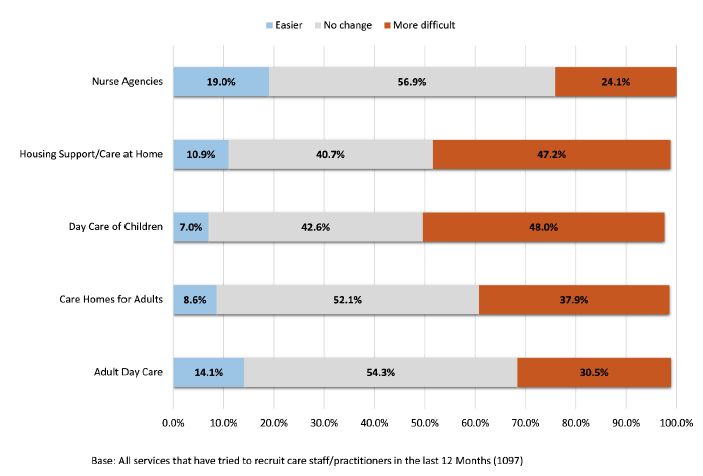
Additionally, respondents working in private sector services were more likely than average to report increased difficulties recruiting such staff (51.8% versus 28.8% of those working for local authorities and 44.3% of those working in the voluntary sector)
As noted previously, the type of post that respondents had most commonly experienced increased difficulty recruiting for was NMC registered nurses. Figure 4.3 shows that this difficulty was felt most acutely among respondents working in care homes for adults and nurse agencies (66.4% and 52.4% versus 15.7% of those working in day care of children and 29.5% of those working in housing support/care at home services respectively). (Small base sizes for adult day care services precludes analysis of the results for this group) [26] .
Figure 4.3: Ease of recruiting NMC registered nurses by sub-sector
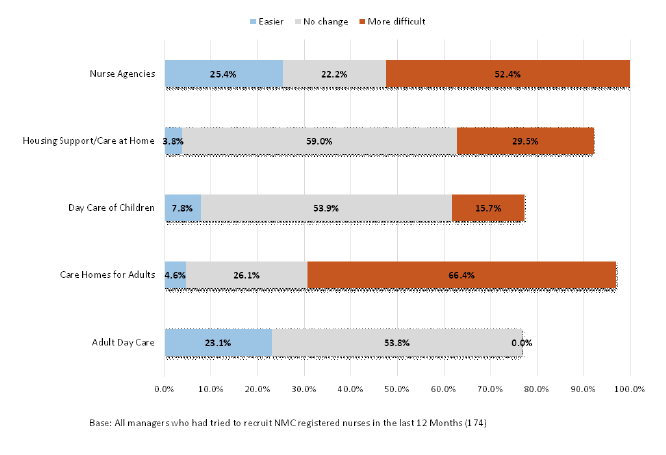
There was further variation by employer type. Respondents working in the private sector were more likely than those working in local authorities and the voluntary sector to report increased difficulties recruiting NMC registered nurses (65.7% versus 13.5% and 15.9% respectively).
For managerial posts, there was no sub-sectoral variation in the results but respondents working in the private sector, along with those working in the voluntary sector, were again more likely than their local authority counterparts to report increased difficulties over the last year (27.0% and 18.1% versus 8.5% respectively).
Ease of recruiting non- UK EU staff
The majority of managers reported no change over the last 12 months in the number of applications they had received from non- UK EU27 nationals, with the figure ranging from 63.0% in the case of applications for care staff or practitioner posts, to 85.2% in the case of managerial posts ( Table 4.2). Indeed, in respect of care staff and practitioner posts, 15.1% of managers reported having received more applications from EU nationals.
The minority saying they had received fewer applications from non- UK EU nationals ranged from 3.5% in respect of applications for managerial posts to a significantly higher 13.1% for care staff or practitioner posts and 14.5% for NMC registered nursing posts.
Table 4.2: number of applications received from non- UK EU27 nationals in last 12 months by post type
| Auxiliary staff | NMC Registered nurses | Care staff/ practitioners | Managers | Other | |
|---|---|---|---|---|---|
| % | % | % | % | % | |
| A lot more | 2.6 | 2.0 | 2.7 | 0.9 | 2.3 |
| A little more | 7.3 | 3.7 | 12.4 | 1.4 | 3.5 |
| No change | 70.4 | 67.5 | 63.0 | 85.2 | 76.5 |
| Slightly fewer | 4.9 | 6.0 | 5.0 | 0.9 | 1.6 |
| Far fewer | 6.2 | 8.5 | 8.1 | 2.6 | 4.7 |
| Don’t know | 8.5 | 12.3 | 8.7 | 9.1 | 11.4 |
| More | 9.9 | 5.7 | 15.1 | 2.3 | 5.8 |
| Fewer | 11.1 | 14.5 | 13.1 | 3.5 | 6.3 |
| Base | 803 | 201 | 1,142 | 892 | 310 |
Small base sizes for nurse agencies precluded full and robust analysis of the above results by sub-sector. However, it appears that respondents working in nurse agencies and in care homes for adults, are more likely than average to have experienced increased difficulties recruiting non- UK EU:
- auxiliary staff (26.9% and 16.4% versus an average of 11.1%);
- care staff/practitioners (33.3% and 17.0% versus 13.1%); and
- NMC registered nurses (26.7% and 16.9% versus 14.6%)
In the case of care staff/practitioners and NMC registered nursing posts, a higher than average proportion of respondents working in housing support/care at homes services similarly reported increased difficulties recruiting non- UK EU nationals to these roles (16.0% and 18.9% compared with the averages of 13.1% and 14.6% respectively).
Retention
Ease of retaining staff in general
The survey results suggest that retention was presenting somewhat less of a challenge for managers than recruitment. Over four in five respondents reported that there had been no change over the last 12 months in the ease with which they had been able to retain auxiliary staff (81.7%), managers (85.5%) and ‘other’ types of staff (82.8%). Fewer, though still a majority, said the same in respect of NMC registered nurses (70.3%) and care staff or practitioners (66.6%). Still, it was notable that just over a quarter (25.7%) reported increased difficulty retaining care staff or practitioners.
Table 4.3: Ease of retaining staff by staff grouping
| Auxiliary staff | NMC Registered nurses | Care staff/ practitioners | Managers | Other | |
|---|---|---|---|---|---|
| % | % | % | % | % | |
| A lot easier | 4.6 | 3.1 | 3.4 | 2.9 | 2.8 |
| A little easier | 2.4 | 4.9 | 3.7 | 2.2 | 1.9 |
| No change | 81.7 | 70.3 | 66.6 | 85.5 | 82.8 |
| A little more difficult | 7.4 | 9.0 | 15.6 | 4.3 | 5.1 |
| A lot more difficult | 2.9 | 9.2 | 10.1 | 3.6 | 4.4 |
| Don’t know | 0.9 | 3.7 | 0.6 | 1.3 | 2.9 |
| Easier | 7.0 | 8.0 | 7.1 | 5.1 | 4.7 |
| More difficult | 10.3 | 18.1 | 25.7 | 7.9 | 9.5 |
| Base | 653 | 206 | 981 | 628 | 300 |
Again, some small base sizes, particularly for nurse agencies, preclude full robust sub-sectoral analysis of the results but it can be said that respondents working in care homes for adults were more likely than average to have experienced increased difficulties retaining NMC registered nurses over the last year (24.2% versus the average of 18.0%).
Additionally, respondents from the private sector were consistently more likely than those working in other sectors to report increased difficulties retaining staff (Table 4.4).
Table 4.4: Percentages reporting increased difficulties retaining staff over last year by employer type
| Auxiliary staff | NMC Registered nurses | Care staff/ practitioners | Managers | Other | |
|---|---|---|---|---|---|
| % | % | % | % | % | |
| All employers | 10.3 | 18.1 | 25.7 | 7.9 | 9.5 |
| Private sector | 13.5 | 23.8 | 32.7 | 10.8 | 10.6 |
| Voluntary sector | 8.1 | 7.5 | 24.6 | 8.5 | 10.2 |
| Local authority | 7.2 | 3.7 | 26.4 | 2.6 | 3.6 |
Ease of retaining non- UK EU staff
In terms of the retention of non- UK EU staff specifically, the results were even more encouraging than those for retention generally. Around eight in ten respondents reported no change in the ease with which they had been able to retain non- UK EU registered nurses (82.1%) and care staff and practitioners (84.1%). Around nine in ten said the same about non- UK EU auxiliary staff (88.3%) and managerial staff (91.4%). The proportion reporting that it had become more difficult to retain non- UK EU staff was consistently below the 10% mark, ranging from just 2.5% in respect of managers to 8.2% for care staff or practitioners.
Table 4.5: Ease of retaining non- UK EU staff by staff grouping
| Auxiliary staff | NMC Registered nurses | Care staff/ practitioners | Managers | Other | |
|---|---|---|---|---|---|
| % | % | % | % | % | |
| A lot easier | 1.6 | 1.0 | 1.5 | 0.2 | 0.4 |
| A little easier | 1.8 | 1.7 | 2.0 | 1.2 | 1.5 |
| No change | 88.3 | 82.1 | 84.1 | 91.4 | 88.0 |
| A little more difficult | 2.8 | 2.0 | 5.9 | 1.9 | 2.0 |
| A lot more difficult | 0.8 | 6.1 | 2.3 | 0.6 | 1.7 |
| Don’t know | 4.7 | 7.2 | 4.3 | 4.7 | 6.3 |
| Easier | 3.4 | 2.7 | 3.5 | 1.4 | 1.9 |
| More difficult | 3.6 | 8.1 | 8.2 | 2.5 | 3.7 |
| Base | 402 | 154 | 646 | 409 | 198 |
Again, small base sizes prevent full, robust sub-group analysis of the results. However, respondents working in nurse agencies and housing support/care at homes services appeared more likely than average to have experienced increased difficulties retaining care staff/practitioners from EU countries (23.4% and 9.4% versus 8.2% on average). No other such sub-sectoral differences were detectable.
Just over one in ten (13.9%) respondents in total said that non- UK EU staff had left their service in the last 12 months – though the figure ranged from a low of 6.9% among those working in adult day care services, to 53.5% among those working in nurse agencies, reflecting the varying penetration of non- UK EU nationals in these different sub-sectors ( Figure 4.4).
Figure 4.4: Services reporting that non- UK EU staff had left in last 12 months
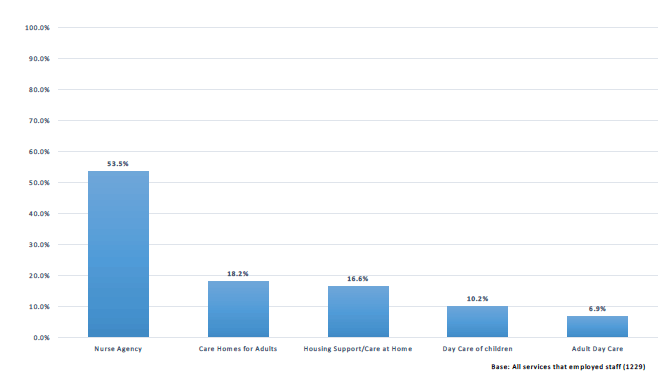
Respondents cited a wide range of reasons why non- UK EU staff had left their service over the last year but the most common of these were promotion or to take up a better job elsewhere (26.6%); to pursue a career change or study (24.2%); and relocation within the UK (21.5%). Relocation to a non- UK EU country was mentioned by 14.9% and Brexit-related concerns by 6.0% ( Figure 4.5).
Figure 4.5: Reasons for non- UK EU staff leaving the sector in the last 12 months
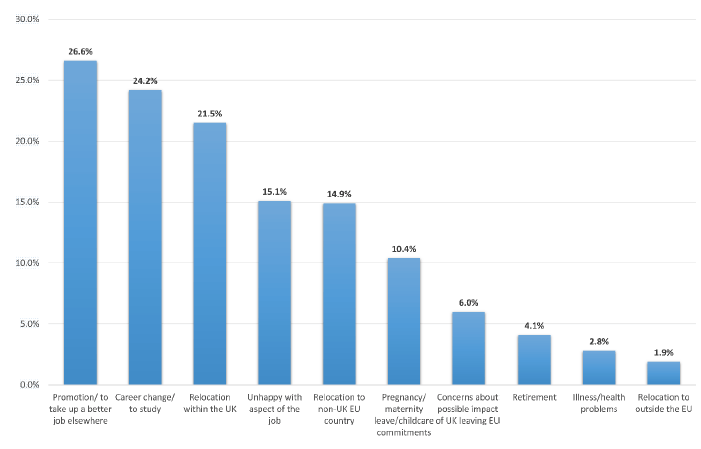
Summary
The survey highlighted some notable variation in the ease of recruiting different categories of staff the social care sector. Over half (51.7%) of those who had tried to recruit NMC registered nurses and over two in five (44.2%) of those who had tried to recruit care staff or practitioners said the process had been more difficult in the last year; this compared with the 21.1% who said the same about recruiting auxiliary staff and the 19.4% who did so in relation to recruiting managers. Private sector care homes had experience particular challenges recruiting register nurses and care staff or practitioners.
Overall, retention was presenting somewhat less of a challenge for managers than recruitment. Still, private sector providers again reported greater difficulties in this regard than their voluntary or public sector counterparts. Indeed, they were more likely to report increased difficulties retaining all types of staff.
The picture in respect of the recruitment and retention of non- UK EU staff specifically was more positive. Majorities of managers reported no change in the number of applications they had received from non- UK EU worker for any type of post in the last 12 months. More still reported no change in the ease with which they had been able to retain non- UK EU workers.
In terms of reasons non- UK EU staff had left the sector, these were many and varied. Brexit was mentioned but much less commonly so than other more ‘everyday’ reasons such as promotion, career change and relocation.
Contact
There is a problem
Thanks for your feedback